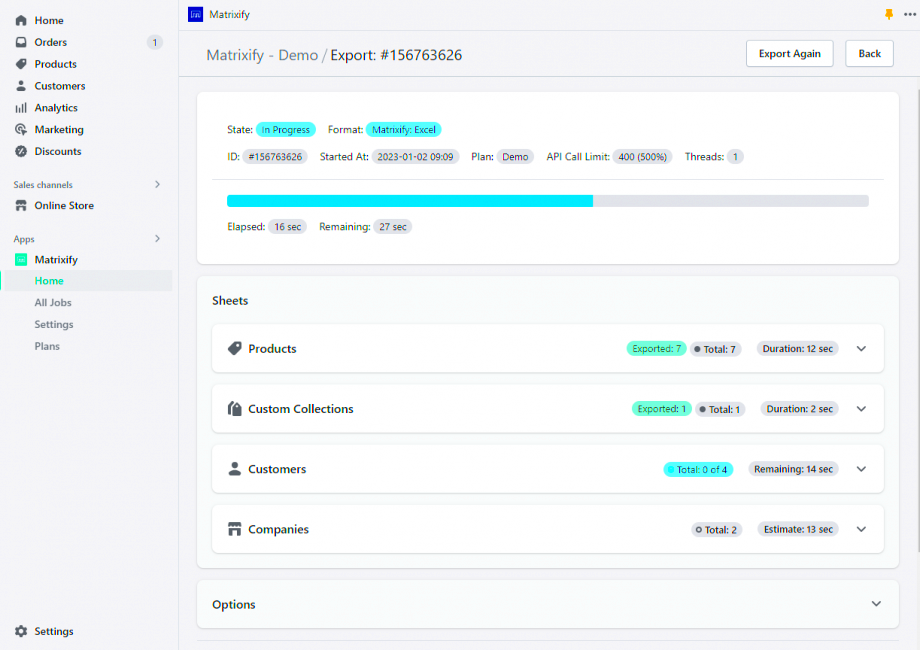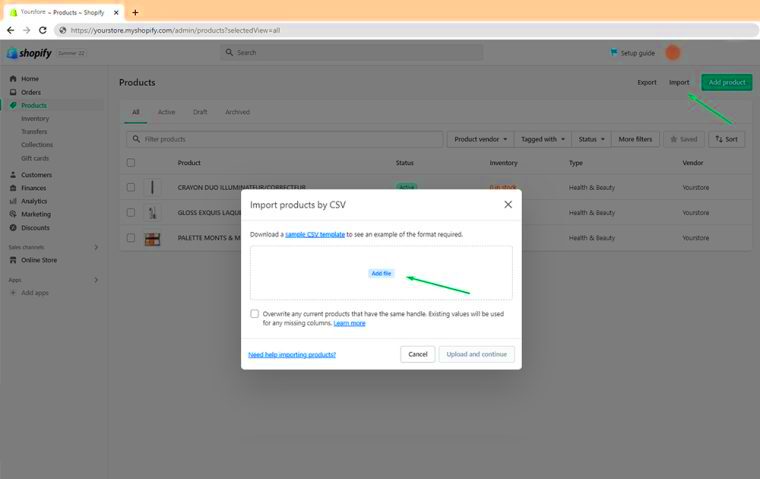Migrating customer data from WordPress to Shopify can be a daunting task, but it doesn’t have to be! Many businesses find themselves needing to switch platforms for various reasons, whether it’s to improve their online store’s functionality, enhance user experience, or take advantage of Shopify’s robust features. In this blog post, we’ll explore the best practices for ensuring a smooth transition that minimizes downtime and protects your valuable customer data.
Understanding the Importance of Data Migration

When it comes to moving your customer data, understanding the importance of a well-planned migration process is crucial. Here are a few reasons why proper migration is vital:
- Data Integrity: Ensuring that all customer information is accurately transferred is essential. Mismatched data can lead to customer dissatisfaction and loss of trust.
- Minimizing Downtime: A well-executed migration helps reduce the amount of time your store is offline, keeping your revenue steady and maintaining customer engagement.
- User Experience: A seamless transition means customers can continue interacting with your store without interruption. This smooth experience is vital for retaining existing customers.
- Compliance and Security: Migrating customer data requires adherence to data protection regulations. Ensuring that customer data is safely transferred to your new platform protects sensitive information.
- Future Scalability: Migrating to a more robust platform like Shopify can pave the way for future growth and scalability, allowing you to easily manage an expanding customer base.
By understanding the importance of these factors, you can prioritize your migration strategy, ensuring a successful transition that benefits both your business and your customers.
Preparing for the Migration Process
Before diving headfirst into the migration process, it’s essential to lay a solid foundation. Proper preparation can save you time, minimize risks, and ensure a smooth transition. Here’s how you can gear up for the big move:
- Assess Your Current Data: Start by auditing your existing WordPress customer data. Identify what needs to be migrated. This includes customers’ details, purchase history, and any specific attributes you’d like to carry over.
- Back Up Your Data: Before you make any changes, back up your WordPress site. Use plugins like UpdraftPlus or BackupBuddy that simplify the backup process. This way, you’ll have a safety net just in case something goes awry during migration.
- Clean Your Data: Take this opportunity to clean up your data. Remove duplicates, fix inaccuracies, and delete obsolete records. Clean data leads to fewer headaches and a more structured Shopify store.
- Plan Your Migration Timeline: Set a timeframe for the entire process. Consider factors like traffic on your current site and the availability of your team. Having a migration timeline helps keep everything organized and efficient.
- Communicate with Your Team: Keep your team in the loop. Explain the migration process, their roles, and any expected downtime. Clear communication reduces confusion and helps everyone contribute effectively.
By meticulously preparing for the migration process, you’re not just setting your Shopify store up for success; you’re paving the way for a seamless transition that leaves your customers satisfied.
Choosing the Right Migration Method
Now that you’re all set up, it’s time to decide how to handle the migration process itself. Picking the right method can dramatically affect the efficiency and outcome of the migration. Here are the most common options to consider:
| Method | Description | Pros | Cons |
|---|---|---|---|
| Manual Migration | Manually export data from WordPress and import it into Shopify. |
|
|
| Automated Migration Tools | Use migration tools like Cart2Cart or LitExtension to handle the process. |
|
|
| Hire an Expert | Bring in a professional to manage the entire process. |
|
|
Choosing the right migration method ultimately depends on your specific needs, budget, and the complexity of your data. Whichever route you take, ensure that you weigh the pros and cons, and make an informed choice that aligns with your business goals!
Backing Up Your WordPress Data
Before diving into the migration process, it’s crucial to back up your WordPress data. Think of it as an insurance policy—just in case anything goes wrong. You wouldn’t want to lose valuable customer information, orders, or even product details during the transition to Shopify. So, let’s break down how to effectively get your backup done.
There are several methods to backup your WordPress data:
- Using a Plugin: Plugins like UpdraftPlus or BackupBuddy can automate the whole backup process. Just install your chosen plugin, set your backup schedule, and you’re good to go!
- Manual Backup: If you’re a bit tech-savvy, you can back up your data manually. This involves downloading your WordPress files via FTP and exporting your database using phpMyAdmin. It sounds daunting, but there are plenty of guides out there.
- Hosting Backup: Some hosting providers offer automatic backups as part of their service. Check if this is available to you, as it can save you a lot of hassle.
Once you’ve completed your backup, verify that all files and data are intact. You can do this by restoring your backup to a test environment. Taking these steps ensures you have a safety net to rely on if anything goes awry during migration to Shopify.
Mapping Customer Data Fields
Now that you’ve secured your WordPress data, it’s time to focus on mapping customer data fields. This step is crucial for ensuring that all your customer information—like names, email addresses, and phone numbers—transfers smoothly from WordPress to Shopify. After all, customer info is the lifeline of your eCommerce business!
Here’s a simple way to approach mapping:
- Identify Key Fields: Make a list of all the essential customer data fields in WordPress, such as:
- First Name
- Last Name
- Email Address
- Phone Number
- Shipping Address
- Order History
- Match Fields: Create a corresponding list for Shopify. This often involves using *customer* and *addresses* formats. For instance, WordPress’s “Shipping Address” might map to Shopify’s “Address”.
| WordPress Field | Shopify Field |
|---|---|
| First Name | First Name |
| Last Name | Last Name |
| Email Address | |
| Phone Number | Phone |
| Shipping Address | Address |
This mapping process ensures no data is lost during migration and keeps your customer relationships intact. A clean and organized mapping will save you time and hassle when importing data into Shopify.
7. Using Migration Tools and Plugins
When it comes to migrating customer data from WordPress to Shopify, using specialized migration tools and plugins can be your best friend! These tools are designed to streamline the process, minimize errors, and save you valuable time. Let’s dive into why they are essential and how you can effectively leverage them for your migration journey.
First off, you’ll find that numerous migration tools cater specifically to WordPress and Shopify users. Popular options include:
- LitExtension: A well-known migration service that enables a seamless transfer of all customer data, including accounts, orders, and reviews.
- Cart2Cart: This tool is user-friendly and supports multiple platforms, making it easier to migrate without technical hassles.
- FG Shopify to WooCommerce: An excellent choice if you are looking for plugin solutions tailored for ease of use.
Here are a few tips for using these migration tools effectively:
- Read reviews: Before selecting a migration tool, check reviews and user feedback to ensure you’re choosing a reliable option.
- Backup your data: Always create a backup of your WordPress data before starting the migration—better safe than sorry!
- Test the process: If the tool offers a test migration, use it! This way, you can ensure everything transfers smoothly.
By taking advantage of these tools, you streamline the migration process, ensuring that your customer data transitions seamlessly from WordPress to Shopify.
8. Testing the Migration Process
Once you’ve migrated your customer data, testing the migration process is a crucial step that you can’t overlook. This phase allows you to double-check that everything has transferred correctly and functions as it should. So, how should you go about testing your migration? Let’s break it down!
Start by reviewing the different types of data you’ve migrated:
- Customer accounts: Check that all accounts have been created successfully with the correct email addresses and passwords.
- Order history: Look over the orders to ensure that they match between the two platforms.
- Reviews and ratings: Verify that customer reviews were successfully imported and display correctly on the Shopify site.
Here are a few steps you can follow for testing:
- Conduct user tests: Get a couple of colleagues or friends to sign up, place orders, and leave reviews to confirm the process works from the user’s perspective.
- Run reports: In Shopify, pull reports on your customer data to check for discrepancies—did all customer data make it over?
- Continue monitoring: Even after everything seems to look good, keep an eye on the metrics in the first few weeks to catch any potential issues.
In summary, thorough testing is your safety net. With careful examination and user feedback, you’ll know that your migration has been successful and your customer data is in tip-top shape on Shopify!
Verifying Data Integrity Post-Migration
Maybe you’ve successfully migrated your customer data from WordPress to Shopify—congratulations! However, the job isn’t done just yet. Verifying data integrity is a crucial step that ensures everything has transferred correctly and that your customer data is reliable. Skipping this step could lead to significant issues down the line, such as lost sales or unhappy customers.
To verify the integrity of your migrated data, consider these best practices:
- Check for Completeness: Compare the number of records in your WordPress database with those in Shopify. For example, if you had 500 customers in WordPress, you should see the same number in Shopify.
- Verify Customer Information: Randomly select a sample of customer records and check that the names, email addresses, and other data fields have been transferred accurately.
- Test User Accounts: If applicable, log into a few customer accounts to ensure that usernames and passwords have been retained and function correctly.
- Look for Duplicates: Run checks to identify if there are any duplicate customer records created during the migration process.
- Conduct a Data Audit: Use data auditing tools to ensure that addresses, phone numbers, and other critical pieces of customer data are accurate and formatted as they should be.
Taking the time to verify your customer data helps build trust with your audience. After all, ensuring that customer details are correct affects not just your store’s performance but also your relationships with your customers.
Updating Your Shopify Store Settings
After migrating all your customer data to Shopify, it’s essential to update your store settings. This isn’t just about aesthetics; it’s about making sure everything runs smoothly for both you and your customers. Shopify comes with a wide range of settings that you can tweak to ensure your online store operates optimally.
Here’s a quick rundown of some key settings you should consider updating:
- Payment Gateways: Make sure that your payment gateways are set up and functioning as they should be. Customers should be able to easily check out using their preferred payment methods.
- Shipping Settings: Adjust shipping rates, zones, and methods based on your new customer base. Reliable shipping options make for happy customers!
- Tax Settings: Update tax rates based on your business location and the regions you ship to, ensuring compliance with local regulations.
- Customer Email Notifications: Customize the emails your customers receive during the order process, from confirmation emails to shipping notifications.
- Store Theme and Design: While this is more of an aesthetic choice, consider how your store design represents your brand. Customize your theme to match your brand identity.
Don’t forget to run a full test of the purchase process after making these updates. It’ll not only give you peace of mind but also ensure that your customers have a seamless shopping experience. Each adjustment you make leads to a more polished and professional store, setting you up for success!
Communicating with Your Customers
When it comes to migrating customer data from WordPress to Shopify, communication is key. Your customers deserve to know what’s happening with their accounts, and keeping them informed can dramatically improve their experience during the migration process. Here are some best practices for effective communication:
- Pre-Migration Announcements: Before you start the migration, send out an email or a post on your website informing customers about the upcoming changes. It’s a good idea to explain what data will be transferred, why you’re making the switch, and how it will benefit them.
- Progress Updates: Keeping your customers in the loop during the migration is crucial. Share regular updates on your website or via email about the status of the migration. This builds trust and helps customers feel involved.
- Post-Migration Information: Once the migration is complete, follow up with your customers through emails or notifications. Let them know that the migration was successful and provide guidance on how to access their accounts on Shopify.
- Support Channels: Establish clear support channels for customers who may have questions or concerns during the transition. Add FAQ sections or dedicated help forums to assist them effectively.
- Feedback Request: After the migration, invite customers to share their thoughts on the new platform. This not only shows that you value their input but also gives you the chance to improve your service based on their feedback.
By strategically planning and executing your communication efforts, you can navigate this transition smoothly, ensuring your customers feel informed and valued throughout the process.
Monitoring and Optimizing After Migration
Congratulations! You’ve successfully migrated your customer data from WordPress to Shopify. But your work isn’t over yet; monitoring and optimizing your new setup is crucial for ensuring long-term success. Here’s how you can keep everything on track:
- Track User Activity: Use analytics tools to track your customers’ behaviors on Shopify. Look for patterns in how they navigate your site, which products they engage with, and how they complete purchases.
- Test Functionality: After migration, thoroughly test all functionalities, including login processes, payment processing, and order fulfillment. Make sure everything operates smoothly to prevent any disruptions for your customers.
- Collect Customer Feedback: Reach out to your customers to gather their feedback about the migration. Questions like “How’s your experience with our new system?” can provide valuable insights into areas that may need improvement.
- Monitor Performance Metrics: Keep an eye on key performance indicators such as conversion rates, abandoned cart rates, and website traffic. Tools like Google Analytics can help you identify trends and issues.
- Iterate and Optimize: Based on the data collected, make necessary adjustments to improve your customers’ experience. This could involve tweaking your marketing strategies, enhancing website navigation, or refining customer service protocols.
By continuously monitoring and optimizing your Shopify store, you’ll ensure a seamless shopping experience that leaves your customers happy and coming back for more.
Conclusion
In conclusion, migrating customer data from WordPress to Shopify is a strategic move that can enhance your online business’s efficiency and functionality. By adhering to the best practices outlined above, you can ensure a smooth transition with minimal impact on your operations and customer experience.
To recap, here are some essential steps to consider during the migration process:
- Backup Your Data: Always create a complete backup of your WordPress database before starting the migration.
- Assess Your Data: Evaluate the structure and quality of your customer data to determine what needs to be migrated.
- Use the Right Tools: Implement reliable migration tools or services that support WordPress to Shopify transfers.
- Create a Migration Plan: Develop a detailed plan that outlines the timeline and responsibilities for the migration process.
- Test the Migration: Conduct a trial migration to identify potential issues and fine-tune your approach.
- Monitor Post-Migration: After migrating, monitor all customer data to ensure accuracy and functionality on the Shopify platform.
- Communicate with Customers: Keep your customers informed about the migration, including any potential changes or improvements they can expect.
Following these best practices will facilitate a seamless and effective transition of customer data, setting a solid foundation for your business’s operations on Shopify.



